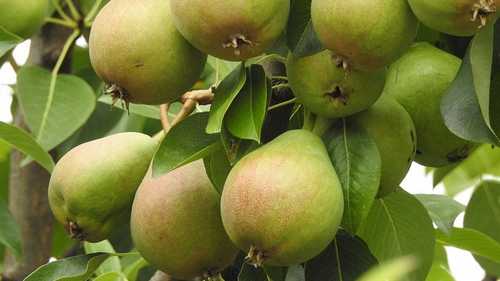This article shows how to grow a pear tree from seeds. Growing a pear tree from seeds can be an immensely rewarding and a gratifying experience, though it requires patience and attention. In this article, I will guide you through the process propagating a pear tree from seed, including pear seed stratification and germination. The method of growing pears from seeds is the same for all types of pears including Asian pear seeds.
The pear tree grown from pear seed do not grow true to type, it may be lacking the qualities of the parent tree. But still it is a good experiment to grow pear trees from seeds, who knows the fruit may be as sweet as the parent tree. The pear tree grown from seed can take several years to bear fruit.
 |
| Pear Tree |
Pear Seeds
From Where to Get Pear Seeds?
Buy a ripe pear from the grocery store. The pear does not have a pit but its inner core at the center contains up to 10 seeds. The seeds from a ripe pear will be hard and of brown or black color, whereas an unripe pear will have soft and white seeds. Only dark color pear seeds will germinate while the white seeds are not suitable for germination.
These pear seeds, like apple and apricot seeds contain a toxin called amygdalin, which on eating release cyanide in gut. So they should not be ingested.
Pear Seed Preparation
Take out the seeds from a ripe pear and wash them. Check the seeds if they are viable. To check seeds viability, place them in water. The viable seeds will sink after 15 minutes. Discard the floating seeds, because they probably may not sprout and will produce week root system. Soak seeds in water for 12 to 24 hours.
Pear Seeds Stratification
The pear seeds need a cold, moist environment as for peach seeds (how to grow peach tree from seeds) to mimic the natural winter conditions that trigger germination. The stratification signals the seeds that it's time to break dormancy and germinate. So it is necessary to make sure to cold stratify and germinate your pear seeds indoors before you plant them in the ground to increase their likelihood of growing into healthy trees.
 |
| Pear Seeds |
How To Stratify Pear Seeds
- Remove the seeds from the water and lay them on a dampened kitchen towel. Fold the paper and enclosed it in a sealable plastic bag and place it in refrigerator for 2-3 month. Do not place in the freezer. If the seeds develop mold, wash them and enclose again in the paper.
- To stratify seeds without mold, you can place the seeds in moist sphagnum moss instead of the paper and seal in a plastic bag.
- You can also stratify seeds in potting soil. Place the seeds in damp potting mix in the Ziploc bag and refrigerator.
Planting the Seeds
The seeds may sprout during the stratification process, my most of the seeds sprouted in the fridge.
Once the stratification period is complete, it's time to plant the seeds. Fill a small pot with well-draining potting soil, and moisten it slightly. Plant the stratified seeds about an inch deep into the soil. Cover the pot with a plastic wrap or place it in a plastic bag to create a humid environment. Place the pot in a warm location with indirect sunlight.
Maintain a consistently moist environment by lightly watering the soil when necessary, being careful not to over-water and cause water-logging. Adequate moisture is crucial during the early growth stages. As the seedlings emerge, remove the plastic covering to prevent excess humidity and ensure proper air circulation. Gradually introduce them to longer periods of direct sunlight to promote healthy growth.
 |
| Germinated Pear Seeds |
Transplanting Pear Plant
when to transplant seedlings to soil
When the seedlings have grown to a height of 6-8 inches and developed several sets of leaves, it is time to transplant them into larger containers or the outdoors. Choose a sunny location with well-drained soil to provide the pear tree with optimal growing conditions. Dig a hole wide and deep enough to accommodate the root system, carefully transfer the seedling, and cover the roots with soil, gently firming it around the base of the tree. Water thoroughly after transplanting to aid root establishment.
Care and Maintenance of Pear Tree
- To ensure the healthy growth of your pear tree, regular care and maintenance are crucial. Water the tree deeply but infrequently, allowing the soil to dry out between waterings.
- Mulching around the base of the tree helps conserve moisture and suppresses weeds.
- Prune the tree during the dormant season to shape it and remove any damaged or diseased branches.
- Fertilize the tree with a balanced, slow-release fertilizer.